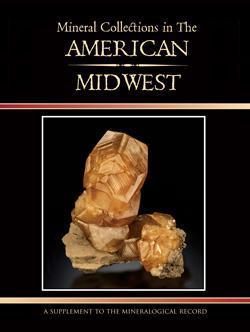
Also available in DIGITAL click HERE!
Mineral Collections in the American Midwest, published as a supplement to the July-August 2015 issue of the Mineralogical Record, gives an exciting look at mineral specimens in the collections of 46 private individuals and four museums in the states of the American Midwest. At 240 pages, it contains nearly 600 gorgeous photos of superb mineral specimens from collections in Minnesota, Iowa, Illinois, Indiana, Michigan, Wisconsin, Missouri, Ohio and Kentucky (plus one just over the border in Tennessee). These are specimens that most collectors would never get to see unless they happened to be personal friends with the collectors whose minerals are featured, or unless they personally visit the Cranbrook Institute, the Wayne State University Museum, the Indiana State Museum and the A. E. Seaman Mineral Museum.
The book begins with “A Brief History of Mineral Collecting in The American Midwest,” recounting some of the most famous collectors and dealers who operated in those states as early as 1820. The Midwest was not a focus of 19th-century mineral dealing like those that existed in New York and Pennsylvania; rather it was primarily the territory of the amateur mineralogist, the rockhound and the lapidary — especially following the end of World War II. Mines and quarries yielded minerals to the miners (especially in the Michigan Copper Country, where collecting was considered a basic right by the miners) and the visiting collectors on a small scale, and roadside mom-and-pop rock shops opened up throughout the Midwest. It was a good place for children to dig rocks, and for families to collect together. Clubs of rockhounds and collectors formed, and eventually joined together in the Midwest Federation. Local mineral shows across the Midwest flourished, giving collectors a chance to meet, compete with each other, and acquire new specimens. Today, much of that activity goes on, and many collections have become sophisticated in a distinctly Midwestern way.
Then follows the main body of the work: individual chapters on museum and on each collector or couple, with biographical notes on their collecting orientations and philosophies, and pictures of their specimens.
